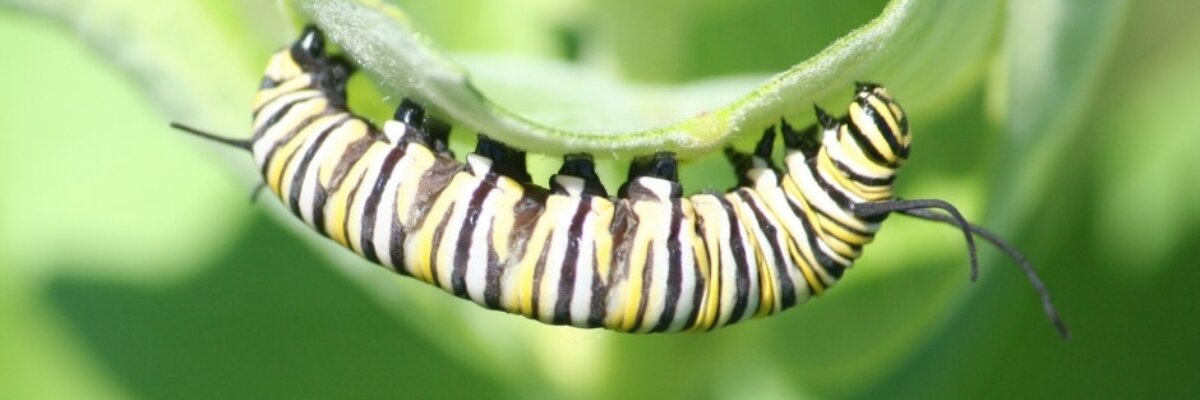
Pests/Pesticides & Other Insects
- What are some reasons a caterpillar might die?
There many reasons why a caterpillar might not survive to adulthood. It can be very difficult to determine exactly what happened to a particular larva, but these are some of the reasons one may die.
There are many diseases and parasites that affect monarchs. Infection can be transmitted between adults and/or larvae, especially if the monarchs are in close proximity. For more information on the risks of rearing monarchs in close proximity to one another, see our handout: Rearing Monarchs: Why or Why Not?
The genetics of each monarch can also determine the outcome of each monarch, some may have a genetic reason they did not survive.
The contamination of milkweed can also reduce the odds of monarch larvae successfully making it to and survive adulthood. If the milkweed the larvae ingest carries pesticides, bacteria or other harmful organisms, this may also be a reason monarchs might not survive.
Monarchs also have many predators that are part of their natural ecosystem.
- Are there other species aside from monarchs (insects or otherwise) that consume milkweed? If so, how do I prevent this from happening, or at the very least limit the amount of competition for milkweed in my yard?
There several species of mammals and insects eat milkweed (see additional post for more details). Milkweed is part of a complex ecosystem that supports many kinds of creatures! Planting large amounts of milkweed will help reduce the competition for milkweed between monarchs and other species as well as any competition for milkweed between monarch larvae. You can also try planting several patches of milkweed in different areas to help distribute the consumption between areas.
- Small white worms (maggots) emerged from my monarch pupa, what are they?
These are tachinid fly larvae. Soon after they emerge from the monarch caterpillar or pupa, they will turn to dark brown pupae. An adult tachinid fly lays her eggs on a monarch caterpillar, then the tachinid larvae burrow inside the monarch caterpillar and develop within it. They emerge from late stage monarch caterpillars or early pupae, killing the monarch.
- Are aphids on milkweed harmful to monarchs?
No, aphids eat the milkweed plant, not monarchs! Ants that may be tending the aphids can sometimes attack small caterpillars on the plant, but the aphids themselves do not harm monarchs.
- Are tachinid flies pollinators?
Some subfamilies (e.g., Phasiinae and Tachinini) are often observed at flowers, and may serve as pollinators, but their importance is not well-studied (Stireman et al. 2006). According to the University of Maryland Extension, adult tachinid flies feed on nectar, pollen, and honeydew from aphids.
- How do you tell a monarch apart from a viceroy or other mimics?
It is easy to mistake a viceroy or other mimic for a monarch. Viceroy butterflies are commonly mistaken for monarchs. They are slightly smaller in size than monarchs, but their largest distinguishing feature is a thick black horizontal (when wings are open) stripe across both hind wings that is missing from monarchs. If you see that distinct stripe, it's a viceroy! The caterpillars and eggs look very different from immature monarchs. For more information about the differences between viceroys, monarchs, and other mimics, download the Monarch SOS app for Apple devices, or see this detailed description from Journey North.
Swallowtail caterpillars are predominately green with yellow dots compared to the yellow, white, and black stripes found on monarch caterpillars. Swallowtails are commonly found on parsley and dill whereas monarchs will only be found on milkweed.
Queen butterfly caterpillars look very similar to monarch caterpillars however the biggest identifier is the 3rd pair of tentacles found on the thorax of the queen caterpillar. Adult queens can be distinguished from adult monarchs by the presence of white dots found on the orange pattern of the forewings. On monarchs, the white dots are contained to the black edges of the wings and do not come in contact with the orange wing cells.
- What is known about the potential impacts of mosquito control on monarchs?
The potential impacts of mosquito control on monarchs will vary based on the control method used. Research has indicated that some mosquito sprays (adulticides) are harmful to Lepidoptera (and many other insects) that get in contact with the spray, while larvicides (often granules of larvicide, such as Bti, applied in water) are less of a cause for worry for Lepidoptera. Adulticides can be Ultra-Low Volume (ULV) pyrethroid sprays that mist a low-concentration of insecticide over an area, and the intention of these is to kill the mosquitoes while they are flying. ULV sprays can cause mortality for flying monarchs that get caught in the mist as well. Barrier treatments are another form of adulticide application, this form settles on leaves and persists after the spray is applied. These may cause problems for monarch larvae on milkweed plants that come in contact with the insecticide spray. A couple of papers that further explain this are available on the monarchnet.org about non-target effects on monarchs from the mosquito control chemicals Permethrin and Resmethrin. These studies' findings indicate that mosquito control spraying increases monarch (and other lepidopterans) mortality as well as increasing sublethal impacts.
Nevertheless, mosquito control is a necessary public health measure to control mosquito populations and aid in the reduction of vector-borne disease. If you observe your area's mosquito control spraying at a time when monarchs are out flying, consider reaching out to that department to see if they can spray at another time when monarchs are less active (monarchs are diurnal, so they are active during the day).
